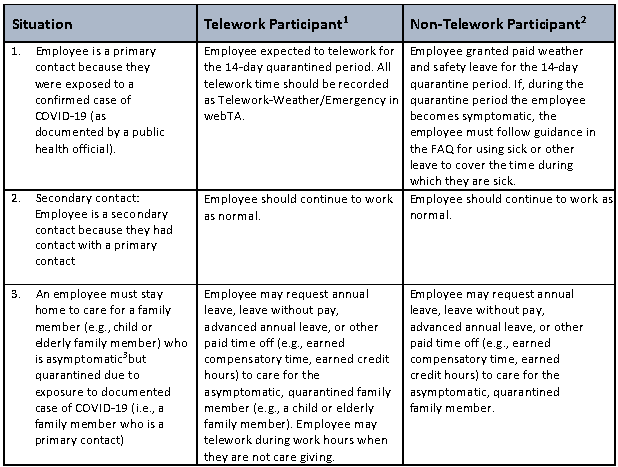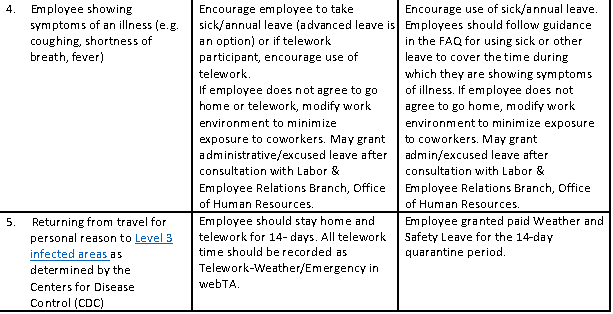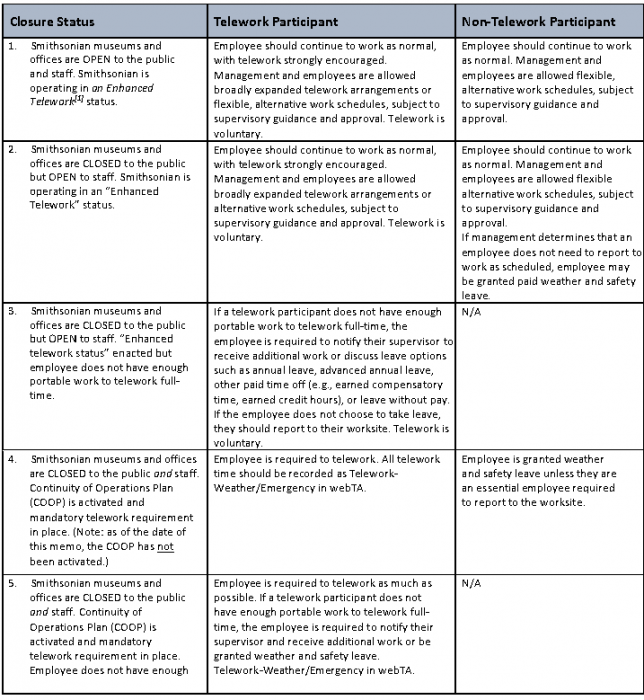COVID-19 UPDATE: Guidance and FAQs on Exposure and Work/Leave Options
These charts apply to both essential and non-essential employees, and are designed to be read together with the FAQs below. Please refer to both when providing guidance to employees. If you have questions about how these charts apply to your situation, please contact your supervisor for guidance. Supervisors can also refer to the Office of Personnel Management FAQ guide issued March 7, 2020.
COVID-19 Exposure and Work/Leave Options
Issued 3/11/20


1 Telework Participant: An employee who already has a signed a telework agreement or an employee who is eligible for ad hoc telework in a COVID-19 emergency (expanded criteria) and has signed an emergency telework agreement.
2 Non-Telework Participant: An employee who is ineligible for telework, even under emergency ad hoc circumstances.
3 “Asymptomatic” – showing no symptoms
COVID-19 Work/Leave Options during SI Closure Status
(Issued 3/13/20)

COVID-19 Telework and Leave FAQs
(Issued 3/13/20)
This guidance applies to essential and non-essential employees. These FAQs and the charts are designed to be read together. Please refer to both when providing guidance to employees.
Telework
Q1. Can a supervisor direct a telework-eligible employee to sign a telework agreement?
A1. Yes. In connection with a closure due to COVID-19, and the Smithsonian Continuity of Operation Plan (COOP) is activated, telework may be leveraged during a COOP activation. All telework-eligible employees should sign telework agreements now. However, telework is still voluntary until the COOP is activated.
Q2. What if a telework-eligible employee refuses to sign a telework agreement?
A2. The supervisor should consult with Labor and Employee Relations staff in the Office of Human Resources for guidance on appropriate next steps.
Q3. If an employee is a non-telework participant and is quarantined under the direction of local or public health authorities, how will they be paid?
A3. The employee’s paid time should be coded as 66 – Weather and Safety Leave.
Q4. If the school systems are closed due to COVID-19, but Smithsonian offices remain OPEN, can a telework program participant perform telework with a child in the home?
A4. Supervisors may allow the employee to telework, as a special exception, in these circumstances. The employee would be expected to account for work and non-work hours during their tour of duty and take appropriate leave (paid or unpaid) to account for time spent away from normal work-related duties (e.g., to care for small children). Weather and safety leave SHOULD NOT be granted to an employee under this scenario.
Q5. If the school systems are closed due to COVID-19 and Smithsonian offices are CLOSED, can a telework program participant perform telework with a child in the home?
A5. Supervisors may allow the employee to telework, as a special exception, in these circumstances. The employee would be expected to account for work and non-work hours during their tour of duty and take appropriate leave (paid or unpaid) to account for time spent away from normal work-related duties (e.g., to care for small children). Weather and safety leave SHOULD NOT be granted to an employee under this scenario.
Q6. What if a telework program participant does not have enough work to cover the full telework day during incidences of COVID-19?
A6. If Smithsonian offices are OPEN and a telework program participant does not have enough work, they are required to notify their supervisor and receive additional work or discuss leave options such as annual leave, advanced annual leave, other paid time off (e.g., earned compensatory time, earned credit hours), or leave without pay. If the employee does not choose to take leave, they should report to their worksite.
If Smithsonian offices are CLOSED, and a telework program participant does not have enough work, weather and safety leave may be granted.
Leave
Q7. What leave options are available to employees who are not telework program participants (i.e., ineligible to telework due to the nature of their job or some other reason)?
A7. If employees are unable to telework in a non-mandatory telework situation, and Smithsonian offices are still OPEN, employees in this category should continue to work. If telework becomes mandatory, and the office is still OPEN, employees in this category should continue to work at their worksite or may request annual leave, leave without pay, advanced annual leave, or other paid time off. Weather and safety leave SHOULD NOT be granted in this scenario.
If Smithsonian offices are CLOSED, employees in this category would be granted weather and safety leave since they are ineligible to telework and cannot report to their worksite.
Q8. If an employee who has been receiving weather and safety leave due to exposure to COVID-19 becomes symptomatic (ill), should they continue to receive weather and safety leave?
A8. No. Sick leave should be used to cover such a period of sickness. If they do not have enough sick leave to cover the absence, the employee may request annual leave, leave without pay, advanced leave or apply for VLTP (voluntary leave transfer program). For additional information on VLTP go to: http://prism2.si.edu/OHR/Transactions/Pages/VLTP.aspx.
Q9. Must an employee have a doctor’s note if requesting to use sick leave for 3 days or more due to an illness from a quarantinable communicable diseases, such as COVID-19?
A9. Not necessarily. An employee’s self-certification as to the reason for his or her absence may be considered administratively acceptable evidence, regardless of the duration of the absence. Supervisors should use their best judgement in these situations.
Q10. If an employee is healthy but chooses to stay home because they have been in direct contact with an individual exposed to a quarantinable communicable disease, such as COVID- 19, in what pay/leave status is the employee placed?
A10. A telework program participant may be allowed to telework during this time. Alternatively, they may also request to take annual leave, advanced annual leave, other paid time off (e.g., earned compensatory time off, earned credit hours), or leave without pay. Weather and safety leave SHOULD NOT be granted to an employee under this scenario unless the employee is quarantined (as ordered by a public health official). The use of sick leave would be limited to circumstances where an employee has become symptomatic (ill).
Q11. If an employee is healthy but stays home because their asymptomatic family member has been quarantined due to exposure to COVID-19, in what pay/leave status is the employee placed?
A11. Currently, an employee may use annual leave, advanced annual leave, other paid time off (e.g., earned compensatory time off, earned credit hours), or leave without pay to stay home with a family member who is healthy but has been quarantined due to COVID-19. A telework program participant may also request to telework. If the employee is not a telework participant and responsible for caring for the healthy family member (such as a small child), they must request annual leave, advanced annual leave, other paid time off (e.g., earned compensatory time off, earned credit hours), or leave without pay. Weather and safety leave SHOULD NOT be granted to an employee under this scenario.
The use of sick leave would be limited to circumstances where an employee has become symptomatic (ill) or the employee’s family member has become symptomatic (ill) due to a quarantinable communicable disease, such as COVID-19.
Q12. What leave options are available for an employee who is not a telework participant but is concerned about getting to work on public transportation?
A12. The employee can request annual leave, or if the employee does not have leave available, they may request advanced leave or leave without pay. Advanced leave must be approved by the unit Director or designee. Leave without pay may be approved by the employee’s supervisor. No other types of leave may be granted in this case.
Q13. What leave options are available to employees who are healthy but are concerned about being at work?
A13. The employee can request annual leave, or if the employee does not have leave available, they may request advanced leave or leave without pay. Advanced leave must be approved by the unit Director or designee. Leave without pay may be approved by the employee’s supervisor. No other types of leave may be granted in this case.
Q14. If an employee is showing symptoms of an illness at work (e.g. coughing, shortness of breath, fever), can a supervisor order the employee to go home and take leave?
A14. The supervisor should encourage the employee to take sick or annual leave. If the employee is a telework participant, encourage the use of telework. If the employee does not agree to go home or telework, the supervisor may choose to modify the work environment to minimize exposure to coworkers (e.g., direct employee to sit in a more isolated area of the office). If this is not possible and the employee refuses to leave, the supervisor may order the employee to leave the worksite after consulting with the Labor & Employee Relations (LER) Branch, Office of Human Resources. In such a scenario, after consulting with LER, the employee would be placed on paid administrative/excused leave.
Q15. Where can I find more information on leave options? A15. More information can be located at:
- Smithsonian Directive 212, Federal Personnel Handbook, Chapter 630, Leave Administration, or
- Smithsonian Directive 213, Trust Personnel Handbook, Chapter 630, Leave Administration.
- Voluntary Leave Transfer Program
Other
Q16. Can employees receive hazardous duty pay or environmental differential pay for incidental exposure to COVID-19?
A16. No. The hazardous duty pay and environmental differential statutes do not authorize a hazard pay differential for incidental exposure to COVID-19.
Q17. Where can employees find information on workers compensation benefits related to COVID-19?
A17. A Smithsonian employee who contracts COVID-19 while in performance of their job duties would have the full coverage of the FECA (Federal Employees Compensation Act) for related medical treatment and for wage loss or disability related to that condition or associated complications.
However, exposure to COVID-19 alone does not constitute a work-related injury entitling an employee to medical treatment under the FECA. The employee must be diagnosed with COVID- 19 to potentially be afforded coverage. To establish coverage, the employee must submit a medical report from a qualified physician reflecting a positive test result for COVID-19 based on established employment-related exposure to COVID-19. The Centers for Disease Control and Prevention (CDC) website contains information about the testing and diagnosis of COVID-19.
The FECA does not authorize payment for provision of preventive measures such as quarantines.
Additional information on worker’s compensation benefits for Federal employees related to COVID-19 can be found at https://www.dol.gov/owcp/dfec/InfoFECACoverageCoronavirus.htm
Q18. What are the options for employees concerned about certain aspects of their job, such as working special events, public programs, or travel?
A18. Employees should speak with their supervisor on the various flexibilities and leave options available. Annual and/or advanced leave or leave without pay may be requested.
Posted: 13 March 2020
-
Categories:
Administrative News , COVID-19 Updates , News & Announcements , Spotlight






